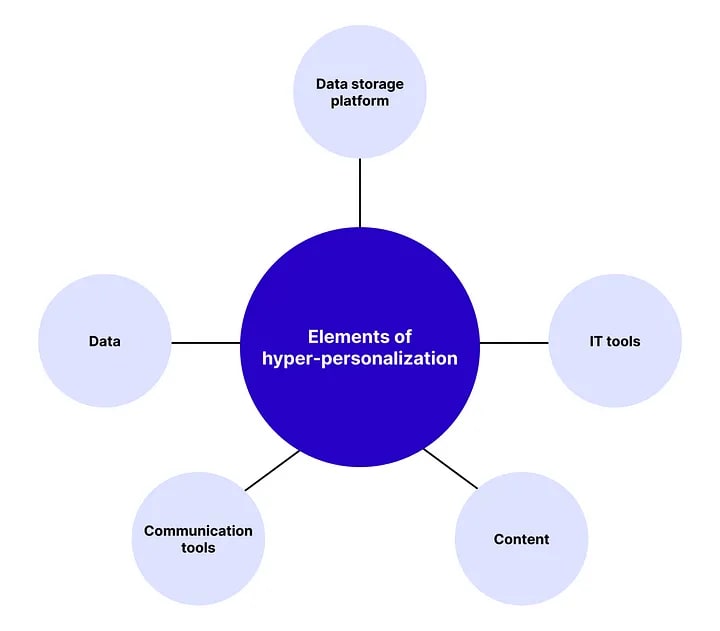
According to Forbes, 62% of customers expect brands to personalize their experiences, and loyalty decreases if those expectations aren’t met. Moreover, customer demands are growing, with users seeking to feel valued and receive individualized offers. Therefore, hyperpersonalization has emerged as a key direction in marketing strategies, expected to persist for years to come.
Artificial intelligence, combined with data, can identify solutions that meet customer needs. This approach enhances loyalty, boosts business revenue, and keeps the brand competitive in a rapidly changing environment.
We’ll delve further into what hyperpersonalization is, how it works, the benefits it brings, and the challenges it faces.
What is hyperpersonalization
Hyperpersonalization is the marketing process of creating content, product offers, and services based on customer requests, identified by artificial intelligence in real-time mode using data.
With this approach, the company’s marketing strategy undergoes a transformation, becoming almost personal and giving customers the feeling of being individually attended to, even though personalization is an automated process. Hyperpersonalization relies on AI and machine learning, with data collected from various sources such as CRM systems, websites, and applications. To ensure quick and efficient operation, information is integrated into a CDP platform. Altcraft Platform consolidates customer data to facilitate and expedite personalization. Email, push notifications, SMS, and messenger broadcasts are sent directly from the service.
How hyperpersonalization is used in marketing
Advertising. With hyperpersonalization, advertisements are precisely tailored to the customer’s preferences. Users see ad offers and creatives that capture their attention. Marketing campaigns also include information about the user’s behavior on the company’s website: views, saved items, and more.
Recommendations. Algorithms analyze customer data and suggest products or content that they will likely enjoy. This method is used in online streaming services.
Real-time notifications. After making a purchase, customers receive messages with personalized offers and discounts based on their previous actions. Notifications from loyalty programs are also sent.
Chatbots. Through AI analysis of user behavior and their previous interactions with the brand, chatbots provide accurate responses and promptly address customer issues.
Examples of hyperpersonalization
Netflix was one of the first to implement hyperpersonalization. Movie and series recommendations are generated after processing large amounts of customer data using artificial intelligence algorithms. This content is not just a selection of similar plotlines and genres but rather tailored to the individual’s values and mindset.

Another example of hyperpersonalization is the unique homepage for each user on Amazon. The accuracy of product recommendations is very high because it takes into account not only past purchases but also the customer’s actions and preferences.

Reebok utilizes hyperpersonalization even for non-registered users. Algorithms track all user actions on the website. With permission to send messages, an individual product list is generated, which is more likely to appeal to the customer.

Difference between personalization vs. hyperpersonalization
Hyperpersonalization in marketing is a new level of personalization where the principle remains the same, but the tools change. It involves a deeper understanding of the customer.
Personalization operates based on accumulated data from past customer purchases. It also takes into account the experiences of individuals with similar characteristics and preferences. For example, online stores often display product recommendations like “people also bought” when selecting an item. A common personalization tactic is addressing customers by name in email campaigns.
Hyperpersonalization, on the other hand, involves a detailed and thorough analysis of customer actions and preferences. It goes beyond just previous purchases to consider specific product characteristics such as color, style, and shape. Recommendations are tailored accordingly. Hyperpersonalization doesn’t rely solely on generalized data from similar profiles; instead, marketing communications with the customer are built on individual traits.
For instance, a fitness app won’t just offer workout programs based on a user’s weight and height but will also gather information from fitness trackers about activity levels. It may also consider body constitution, injuries, and past sports experience.
Elements of hyperpersonalization
To make hyperpersonalization work, you need:
- Data — information about orders, user activity on online sources, personal details to create an individual customer journey.
- Data storage platform to create comprehensive profiles for each customer and not lose important details. With Altcraft Platform, your database includes personal, demographic, and behavioral information. It takes into account all loyalty programs in which the customer participates, as well as their connections with other users.
- AI tools — Hyperpersonalization is not possible manually due to the large volumes of information. AI and machine learning analyze the customer’s journey, anticipate their needs, and predict behavior.
- Content tailored individually to identified customer needs and their readiness to make a purchase.
- Communication tools to maintain omnichannel presence and deliver information to the customer at the right time. It’s important that these are well-thought-out systems that optimize content for different devices. In Altcraft Platform, mailings are done in a single-window mode, taking into account all customer data.

Advantages of hyperpersonalization
- Acceleration of the customer journey. Hyperpersonalization eliminates unnecessary searches for the desired product, and precise offers guide the customer through the sales funnel.
- Increase in loyalty. Highly accurate personalization builds greater trust in the brand. Customers understand that they are valued and their needs are considered, leading to increased loyalty towards the company.
- Enhancement of engagement. Content and email campaigns are tailored to the user’s interests, motivating them to interact more actively with the brand.
- Improvement of market position. Hyperpersonalization enhances a brand’s competitiveness through high-level service. Additionally, the company becomes more technologically advanced, strengthening its position in the market.
- Attraction of new audiences. A personalized approach is always a pleasant bonus for customers who expect high-quality service. If a brand utilizes hyperpersonalization, it becomes another marketing advantage.
- Revenue growth. All the points described above directly or indirectly impact sales. With the right and personalized offers, customers make purchases faster and return for more, as the brand knows exactly what they want. This leads to the formation of stable relationships with customers, which generate revenue for the company.
- Simplification of marketing work. A hyperpersonalized approach is only possible with the use of IT technologies, which take on routine and time-consuming tasks, as well as eliminate human errors. This leaves marketers with more time for creative tasks and strategies.
Problems of hyperpersonalization
Although hyperpersonalization may seem like a “magic pill,” this approach has its drawbacks.
Cost and time investment. Implementing tools for hyperpersonalization can be expensive, but it pays off in the long run. Additionally, time needs to be spent gathering customer data, changing processes, and training employees to work differently.
Uncertainty about where to apply hyperpersonalization. Brands may act differently in this regard. Some use anonymous data (e.g., from the website) to make offers to users even before they log in. Or they start working with the customer once they have provided their data.
In the first case, individuals may be startled by personalized messages because they feel they are being monitored. Such anticipation is not always perceived positively.
In the second case, the brand needs to wait until the customer logs in. Before this moment, hyperpersonalization simply cannot be achieved. It is also important to ensure the security of user data, which is only possible with reliable IT solutions.
Summary
Hyperpersonalization is an approach in marketing where individual offers and content are tailored to the customer’s interests through artificial intelligence and processing of large amounts of data. Unlike regular personalization, this process differs in the depth of analysis of customer needs: it takes into account not only previous choices but also values and preferences.
To implement a hyperpersonalized approach, large volumes of data, special software, content, and communication tools are required. Then the company will increase loyalty, engagement, strengthen its position in the competitive market, and also generate more revenue because sales will increase. Despite all the advantages, it is important to consider the specifics of hyperpersonalization: the high cost of implementation, responsibility for data storage, time spent on working with information and restructuring processes, as well as the absence of a single correct solution for when to start personalization.
The article was originally published here.
About the Creator
Altcraft
Interesting and useful articles about marketing, our product and online communications






Comments
There are no comments for this story
Be the first to respond and start the conversation.